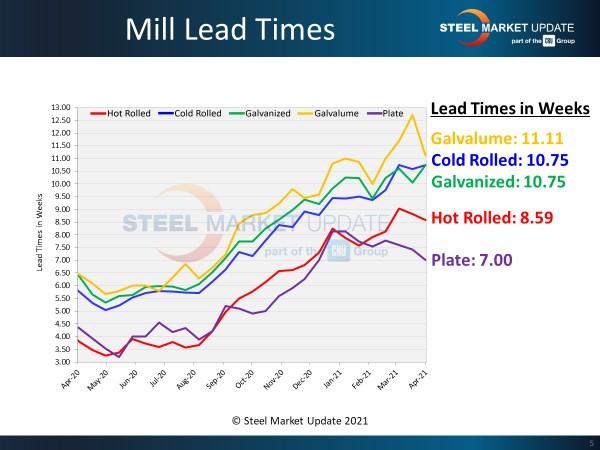President/CEO
- FMA
- The Fabricator
- FABTECH
- Canadian Metalworking
Categories
- Additive Manufacturing
- Aluminum Welding
- Arc Welding
- Assembly and Joining
- Automation and Robotics
- Bending and Forming
- Consumables
- Cutting and Weld Prep
- Electric Vehicles
- En Español
- Finishing
- Hydroforming
- Laser Cutting
- Laser Welding
- Machining
- Manufacturing Software
- Materials Handling
- Metals/Materials
- Oxyfuel Cutting
- Plasma Cutting
- Power Tools
- Punching and Other Holemaking
- Roll Forming
- Safety
- Sawing
- Shearing
- Shop Management
- Testing and Measuring
- Tube and Pipe Fabrication
- Tube and Pipe Production
- Waterjet Cutting
Industry Directory
Webcasts
Podcasts
FAB 40
Advertise
Subscribe
Account Login
Search
High steel prices not eroding demand across industry—yet
New steelmaking capacity is coming, just not soon enough for metalworking sectors
- By John Packard and Tim Triplett
- April 30, 2021

Steel prices have reached record highs and lead times are increasing. Reports indicate that some service centers are turning away spot buyers because they simply don't have the inventory. Getty Images
Steel prices just keep moving higher and higher. At some point, prices will get too high, and fabricators and manufacturers will stop buying. Demand will stall. Or so goes the conventional wisdom. But it hasn’t happened yet, and it may not this year.
Steel Market Update (SMU) polls steel buyers every week to keep tabs on market conditions. As of mid-April, few reported any signs of high steel prices eroding demand. Half said demand was stable. And more than 40% said demand for their products and services was growing. Only 6% reported declining demand. Here’s what a few of them had to say:
- “Demand is remaining the same at a very high level.”
- “We're heading into our busy season, and we're already busy. We had record sales in March.”
- “If you have spare tons, consider them sold.”
- “The bulls are running!”
SMU also asked: “Have you seen any indications that record-high steel prices might be near a tipping point?” The vast majority, nearly 80%, reported no signs of a change in the market’s direction. Some of their comments were:
- “The domestics are staying tight with pretty much no spot availability, and now imports are raising pricing to very unattractive levels. We aren’t tipping it!”
- “Lead times are still extended, and mills are still running late.”
- “There are too many good demand factors that will keep prices stable at these high numbers.”
- “Maybe large amounts of incoming steel from overseas might help drop domestic prices a bit, but that’s a big maybe.”
SMU’s survey of the market on April 12-14 revealed a benchmark price for hot-rolled coil (HRC) of $1,370/ton (see Figure 1). That’s incredibly high. It also was almost entirely unexpected so close on the heels of a black swan event like the pandemic. HRC prices have set new highs week after week since January as the economy recovered from the pandemic. At $1,370/ton, HRC is selling for triple its 2020 low of $440/ton, which occurred last August. That price also is $300/ton more than the previous supercycle for commodities in 2008. (A supercycle occurs when supply for a commodity is so inadequate when compared to demand growth that prices rise for an extended period of time.) Cold-rolled and coated steel prices have experienced similar inflation.
Why the runup in steel prices? Simply put, an imbalance between supply and demand. When the economy shut down last spring to stem the spread of the coronavirus, steel demand plummeted, and mills idled capacity. Fueled by government stimulus, the economy and steel demand have come roaring back. But steel production has not. Steelmakers have taken advantage of the situation to conduct much-needed maintenance on furnaces and other equipment, and it appears they are in no hurry to correct an imbalance that is delivering record profits
.Buyers have told SMU that almost all the steel being produced is for contract customers and that the few spot tons available are selling at a huge premium. Mills’ lead times have extended to more than eight weeks for hot-rolled and nearly 11 weeks for cold-rolled and coated products—more than double traditional lead times (see Figure 2).
Service centers are operating with record-low inventories—an average of just 1.8 months of supply at the end of March, according to SMU’s proprietary data. That’s more than six inventory turns per year, far leaner that the normal four turns. Most service centers would welcome the opportunity to buy more steel if it were available. Because they cannot get more tons, some have had to turn customers away.
SMU also regularly asks buyers to predict when and at what level steel prices will peak. In every instance since late last year, the consensus view has been wildly incorrect. Namely, buyers consistently agree that a peak is nearby, and then prices continue to march significantly higher. So take the following with a grain of salt: As of mid-April, the prevailing view was that hot-rolled prices would continue rising to at least $1,400/ton. About half of the buyers contacted by SMU predicted that prices would at last lose their upward momentum by June. The reason: additional domestic capacity colliding with increased import volumes. But almost as many, around 38%, said it might be well into the second half before steel prices moderate as supply catches up with demand. Here are some buyers’ comments:
- “There is zero chance we don't see $1,400/ton hot-rolled.”
- “No spot supply plus strong demand plus record-low service center inventories equals higher prices. It’s simple economics.”
- “There’s still room for U.S. prices to increase near term, especially as the rest of the world begins to accelerate again.”
- “There is little to no spot, and mills are booked well into the third quarter, so pricing has little or no bearing right now. Once the imports start hitting, then you will see pricing that has some meaning.”
- “There may be a little upside, but we are at or near the top. Having said that, we don’t believe prices will be retreating anytime soon.”
It’s important to note that considerable additional supply is in the works. Big River Steel has fired up a second electric-arc furnace at its mill in Osceola, Ark. JSW USA has restarted its EAF in Mingo Junction, Ohio. Union members are now back to work at the NLMK USA mill in Farrell, Pa., following a lengthy strike. Steel Dynamics Inc. is on track to begin production at its new mill in Sinton, Texas, sometime this summer, as is Ternium in Mexico. A large volume of imports also is forecast to begin arriving in the U.S. this summer and into the fall.
But the demand side of the equation also is in flux. The U.S. economy is booming thanks to the government stimulus to counter the pandemic. Positive weather in most of the country has gotten the construction season off to a good start. Automakers have been hobbled by a worldwide shortage of microchips, which is likely to push some vehicle production into the second half of the year. And the Biden administration is pushing for trillions in new infrastructure spending, though most of that work and steel consumption won’t manifest until 2022 and beyond.

Figure 1. Prices for hot-rolled coil continue to climb well into April, and many steel buyers think it might not end there.
Where and when supply and demand will meet in the middle remains a puzzler, one with big consequences for steel buyers.
SMU Conferences and Workshops
Presuming COVID inoculations continue apace, the annual SMU Steel Summit Conference will be in person Aug. 23-25 at the Georgia International Convention Center in Atlanta. Visit www.events.crugroup.com/smusteelsummit/home for more information.
To sign up for a free trial of SMU’s newsletter, contact paige@steelmarketupdate.com.
subscribe now

The Fabricator is North America's leading magazine for the metal forming and fabricating industry. The magazine delivers the news, technical articles, and case histories that enable fabricators to do their jobs more efficiently. The Fabricator has served the industry since 1970.
start your free subscriptionAbout the Authors

John Packard
800-432-3475
John Packard is the founder and publisher of Steel Market Update, a steel industry newsletter and website dedicated to the flat-rolled steel industry in North America. He spent the first 31 years of his career selling flat-rolled steel products to the manufacturing and distribution communities.

Tim Triplett
Executive Editor
- Stay connected from anywhere

Easily access valuable industry resources now with full access to the digital edition of The Fabricator.

Easily access valuable industry resources now with full access to the digital edition of The Welder.

Easily access valuable industry resources now with full access to the digital edition of The Tube and Pipe Journal.
- Podcasting
- Podcast:
- The Fabricator Podcast
- Published:
- 04/16/2024
- Running Time:
- 63:29
In this episode of The Fabricator Podcast, Caleb Chamberlain, co-founder and CEO of OSH Cut, discusses his company’s...
- Trending Articles
AI, machine learning, and the future of metal fabrication

Employee ownership: The best way to ensure engagement

Steel industry reacts to Nucor’s new weekly published HRC price

Dynamic Metal blossoms with each passing year

Metal fabrication management: A guide for new supervisors

- Industry Events
16th Annual Safety Conference
- April 30 - May 1, 2024
- Elgin,
Pipe and Tube Conference
- May 21 - 22, 2024
- Omaha, NE
World-Class Roll Forming Workshop
- June 5 - 6, 2024
- Louisville, KY
Advanced Laser Application Workshop
- June 25 - 27, 2024
- Novi, MI



























